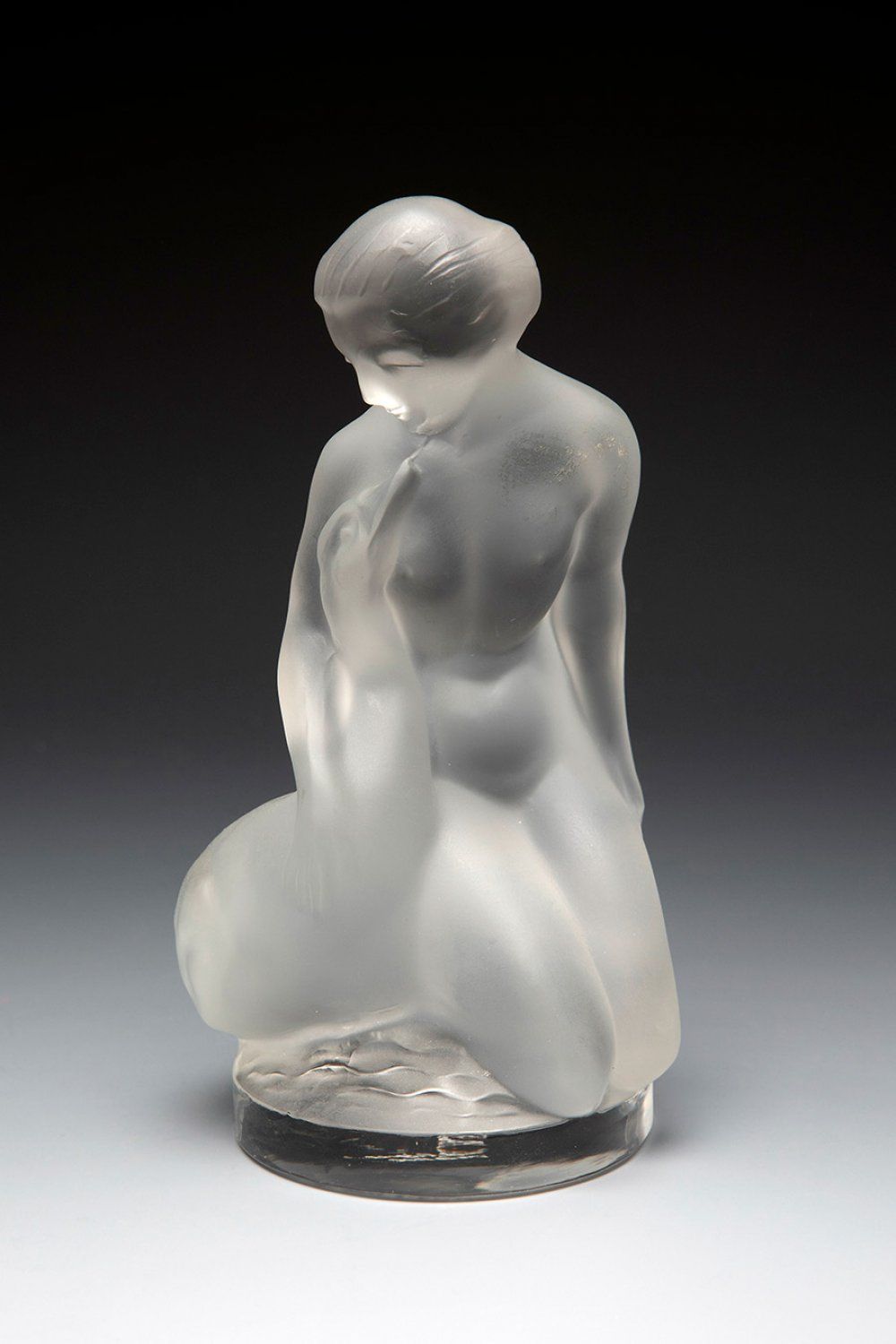Description
LALIQUE. "Leda and the Swan. France, ca. 1960. Figure in moulded and satin-finished glass. Signed on the reverse of the base Lalique-France. Provenance: Private collection, Spain between 1970-1990. Measurements: 12 cm (height); 6.5 cm (diameter). This Lalique design dates from Lalique's post-war period, but we have not been able to definitively identify the designer. Some references attribute it to Marc Lalique (son of René Lalique), others to Marie-Claude Lalique (daughter of Marc/granddaughter of René). In classical Greek mythology, Leda was the daughter of the Aetolian king Testius and wife of King Tyndareus of Sparta, and legend has it that Leda was seduced and then raped by Zeus, who took the form of a swan. On the same day she also slept with her husband, King Tindarus. Leda had four children: Helen (later Helen of Troy) and Polideuces by Zeus, and Castor and Clytemnestra by her husband. The firm Lalique was originally founded by René Jules Lalique (1860 - 1945), one of the most prominent glassmakers of the time, and one of the first to sculpt glass for great monumental works, such as the fountains on the Champs Elysées. He enjoyed great renown for his original creations of jewellery, perfume bottles, glasses, plates, etc., in the Art Nouveau and Art Deco styles. He trained with the Parisian jeweller Louis Aucoq, and then continued his studies at Sudenham Art College in London. The excellence of his creations and the taste he applied to his work earned him important commissions for the interior decoration of ships, trains such as the Orient Express, churches such as Saint-Nicasius in Reims, and numerous religious and civil goldsmiths' works. Lalique was not content with simply designing his models, but also founded a factory to produce them in large quantities, patenting several innovative glass manufacturing processes, and various technical effects such as "Lalique satin" or opalescent glass. Pieces by Lalique are preserved in prominent museums such as the Corning Museum of Glass and the Metropolitan Museum of Glass in New York, the Louvre and the Orsay Museum in Paris, among many others.
29
LALIQUE. "Leda and the Swan. France, ca. 1960. Figure in moulded and satin-finished glass. Signed on the reverse of the base Lalique-France. Provenance: Private collection, Spain between 1970-1990. Measurements: 12 cm (height); 6.5 cm (diameter). This Lalique design dates from Lalique's post-war period, but we have not been able to definitively identify the designer. Some references attribute it to Marc Lalique (son of René Lalique), others to Marie-Claude Lalique (daughter of Marc/granddaughter of René). In classical Greek mythology, Leda was the daughter of the Aetolian king Testius and wife of King Tyndareus of Sparta, and legend has it that Leda was seduced and then raped by Zeus, who took the form of a swan. On the same day she also slept with her husband, King Tindarus. Leda had four children: Helen (later Helen of Troy) and Polideuces by Zeus, and Castor and Clytemnestra by her husband. The firm Lalique was originally founded by René Jules Lalique (1860 - 1945), one of the most prominent glassmakers of the time, and one of the first to sculpt glass for great monumental works, such as the fountains on the Champs Elysées. He enjoyed great renown for his original creations of jewellery, perfume bottles, glasses, plates, etc., in the Art Nouveau and Art Deco styles. He trained with the Parisian jeweller Louis Aucoq, and then continued his studies at Sudenham Art College in London. The excellence of his creations and the taste he applied to his work earned him important commissions for the interior decoration of ships, trains such as the Orient Express, churches such as Saint-Nicasius in Reims, and numerous religious and civil goldsmiths' works. Lalique was not content with simply designing his models, but also founded a factory to produce them in large quantities, patenting several innovative glass manufacturing processes, and various technical effects such as "Lalique satin" or opalescent glass. Pieces by Lalique are preserved in prominent museums such as the Corning Museum of Glass and the Metropolitan Museum of Glass in New York, the Louvre and the Orsay Museum in Paris, among many others.
